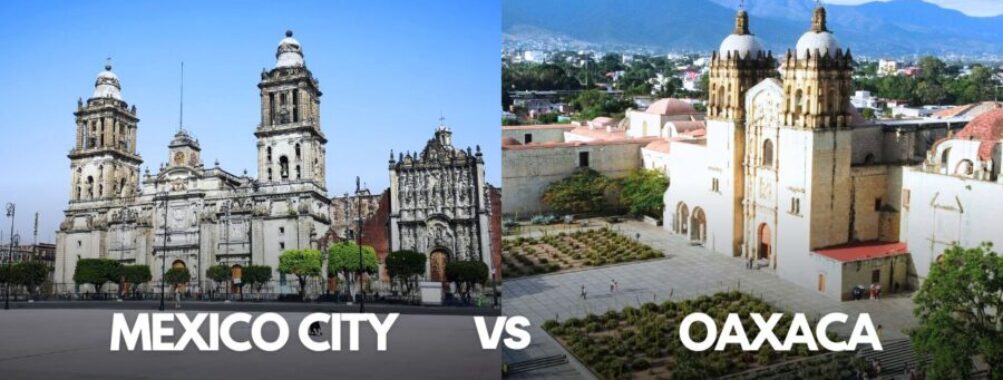
Mexico City vs Oaxaca: 7 Essential Differences to Know Before Your 2025 Mexican Adventure
When travelers dream of Mexico, two destinations often battle for attention: the sprawling metropolis of Mexico City and the charming colonial city of Oaxaca. Both places offer incredible experiences, but they couldn’t be more different from each other.
Mexico City dazzles with its vast size, endless activities, and frenzied energy, while Oaxaca charms with its walkable streets and traditional culture. And a relaxed atmosphere.
The capital is modern Mexico’s most exciting – museums, restaurants, and neighborhoods that could keep you busy for weeks. Oaxaca, though smaller, packs a powerful punch with its incredible food scene, indigenous crafts, and beautiful architecture.
Can’t decide between them? You’re not alone. Many travelers struggle with this choice, especially with limited vacation time.
Both cities showcase different sides of Mexican culture. Whether you choose the cosmopolitan capital or the cultural heart of Oaxaca, you’ll experience the warmth and beauty that make Mexico a special destination.
Contents
- Historical Significance and Heritage
- The Aztec Roots of Mexico City
- Oaxaca’s Indigenous Cultures and Legacy
- Cultural Exploration
- Vibrant Art Scenes in Mexico City and Oaxaca
- Language and Literature: Voices of Two Worlds
- Savoring Traditions: Festivals and Ceremonies
- Urban Development and Architecture
- Colonial Influences and Contemporary Designs in Mexico City
- Oaxaca’s Architectural Harmony with Nature
- Culinary Journey
- Distinct Flavors of Mexico City
- Savor the Unique Tastes of Oaxaca
- Artisan Work and Craftsmanship
- Handcrafted Textiles and Crafts from Oaxaca
- Mexico City’s Evolving Modern Crafts Scene
- Contemporary Lifestyle Comparisons
- The Bustling Streets of Mexico City: Work and Leisure
- The Relaxed Rhythms of Oaxacan Life
- Economic Perspectives
- Business and Economy in the Capital
- Oaxaca’s Local Markets and Economic Practices
- Natural Landscapes and Outdoor Activities
- Lush Parks and Green Spaces in Mexico City
- Oaxaca’s Breathtaking Nature and Ecotourism
- Frequently Asked Questions
- What unique experiences distinguish Oaxaca from Mexico City during the Day of the Dead celebrations?
- How should one split their time between Mexico City and Oaxaca for an optimal 7-day itinerary?
- Can you compare the cultural significance of baseball in Mexico City and Oaxaca?
- What are the best modes of transportation for traveling between Mexico City and Oaxaca, considering comfort and experience?
- How do the costs of accommodations, dining, and activities compare between Mexico City and Oaxaca?
- How do the offerings in Mexico City and Oaxaca differ for those interested in the arts and culinary scenes?
- More Travel Guides
Historical Significance and Heritage
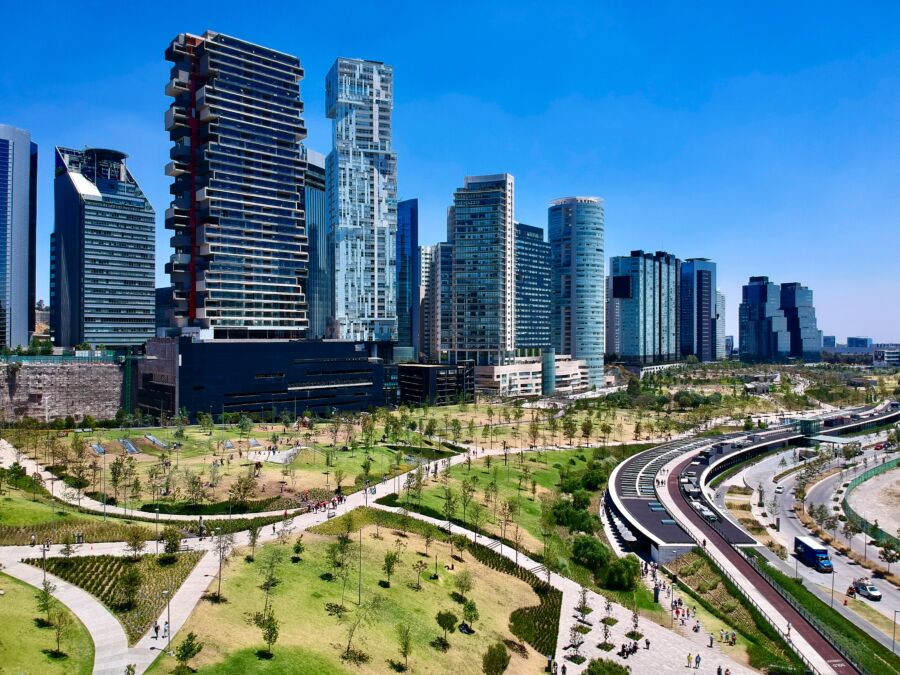
Both Mexico City and Oaxaca showcase the rich tapestry of Mexico’s past. These destinations offer travelers unique glimpses into the country’s ancient civilizations and colonial history through architecture, museums, and cultural traditions.
The Aztec Roots of Mexico City
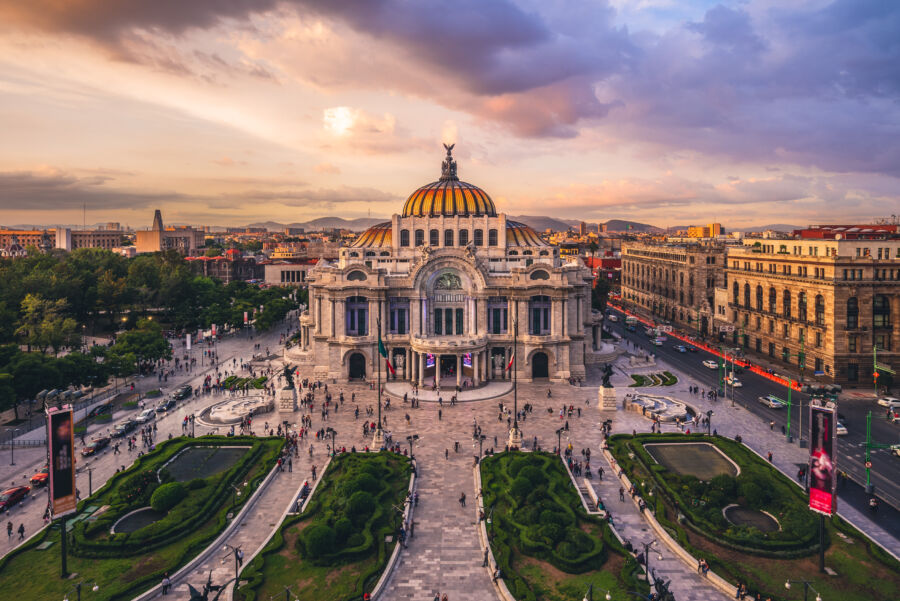
Mexico City stands on the ruins of Tenochtitlan, the magnificent Aztec capital founded in 1325. The city’s historic center reveals layers of history with remnants of Templo Mayor right beside the colonial-era Metropolitan Cathedral.
Just outside the city, Teotihuacan features the incredible Pyramids of the Sun and Moon, which date back to 100 BCE. These massive structures predate even the Aztecs, who were so impressed they named this ancient metropolis “the place where gods were created.”
Mexico City’s National Museum of Anthropology houses the famous Aztec Calendar Stone and countless artifacts that tell the story of pre-Hispanic civilizations. Walking through the museum feels like traveling through time.
The Spanish conquest in 1521 transformed the Aztec capital, but indigenous roots remain visible throughout the city in everything from street names to culinary traditions.
Oaxaca’s Indigenous Cultures and Legacy
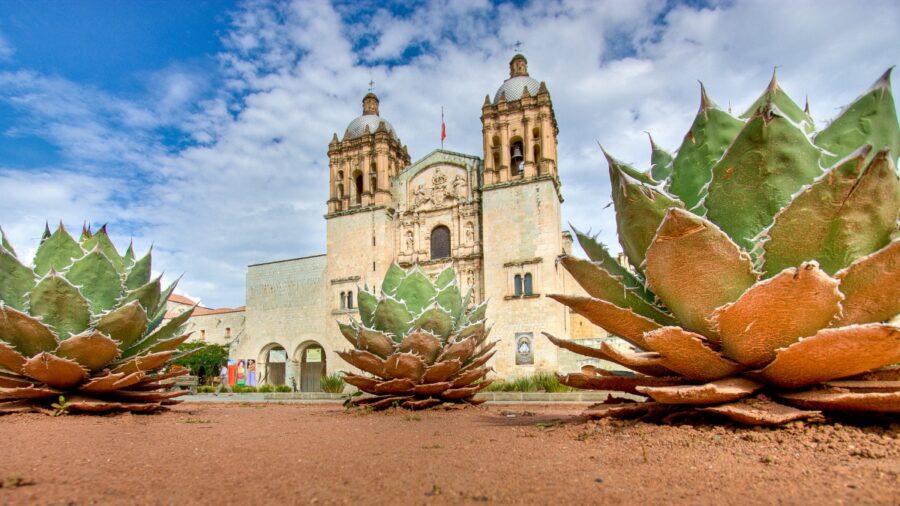
Oaxaca is a living museum of indigenous heritage, particularly from the Zapotec and Mixtec civilizations. The remarkable archaeological site of Monte Albán, perched on a mountain plateau, served as the Zapotec capital for nearly a thousand years.
Over half the population of Oaxaca maintains its indigenous heritage, and many still speak native languages alongside Spanish. This cultural continuity makes Oaxaca unique among Mexican destinations.
The region’s artistic traditions reflect this indigenous influence. Intricate textiles, black clay pottery, and colorful alebrijes (carved wooden figures) showcase techniques passed down through generations.
Mitla, another important archaeological site near Oaxaca City, features stunning geometric stone mosaics that demonstrate the mathematical precision of ancient Zapotec architects. The site’s name comes from the Nahuatl word “Mictlan,” meaning “place of the dead.”
Cultural Exploration
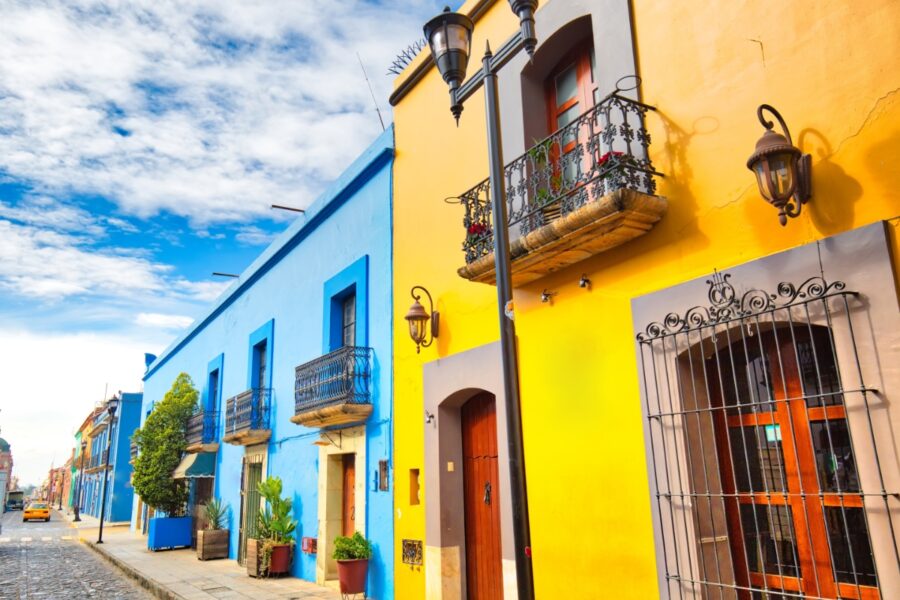
Mexico City and Oaxaca offer profound cultural experiences with artistic heritage, linguistic traditions, and vibrant celebrations. Both cities showcase Mexico’s rich cultural tapestry through different lenses.
Vibrant Art Scenes in Mexico City and Oaxaca
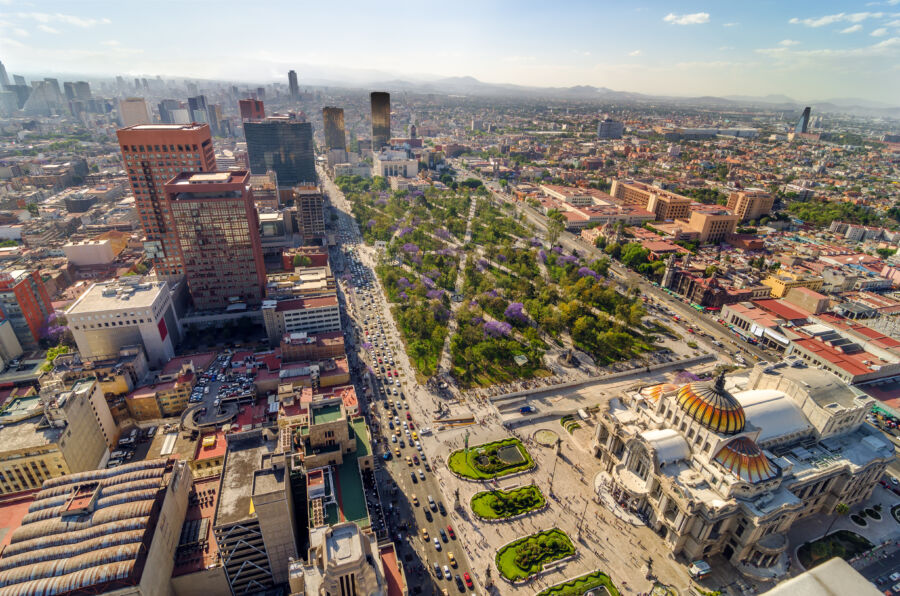
Mexico City boasts a world-class art scene with iconic museums and galleries. The Frida Kahlo Museum (Casa Azul) in Coyoacán gives visitors intimate glimpses into the legendary artist’s life and work. For modern art lovers, the Museo Jumex and Soumaya Museum display impressive contemporary collections.
Oaxaca’s art scene feels more intimate but equally rich. The city is famous for its folk art traditions, particularly alebrijes (brightly colored animal sculptures) and black clay pottery from nearby villages. Many artists maintain open workshops where visitors can watch them create.
The difference? Mexico City tends toward contemporary and international art movements, while Oaxaca celebrates indigenous artistic traditions that have thrived for centuries. Both cities feature vibrant street art that tells stories of local culture and political expression.
Language and Literature: Voices of Two Worlds
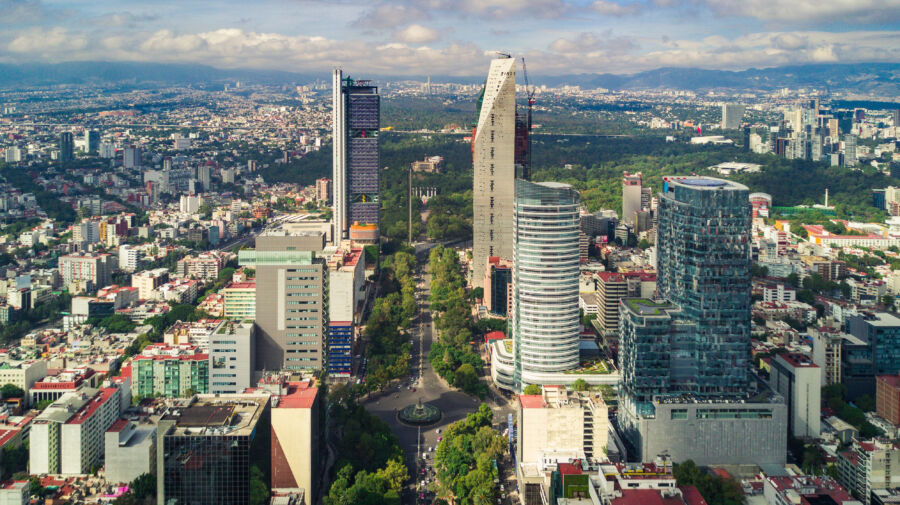
Mexico City serves as the country’s literary hub, home to major publishing houses and literary festivals. The city has nurtured famous authors like Octavio Paz and Carlos Fuentes. Bookstores like Cafebrería El Péndulo combine literature with café culture, creating spaces for intellectual exchange.
Oaxaca presents a more linguistically diverse landscape. While Spanish dominates in both cities, Oaxaca maintains stronger connections to indigenous languages, particularly Zapotec and Mixtec. This linguistic diversity shapes local literature and storytelling traditions.
Literary walking tours in both cities reveal settings from famous Mexican novels. Mexico City’s historic center features prominently in works by Juan Rulfo, while Oaxaca’s colonial streets have inspired countless poets and storytellers who capture the region’s unique cultural blend.
Savoring Traditions: Festivals and Ceremonies
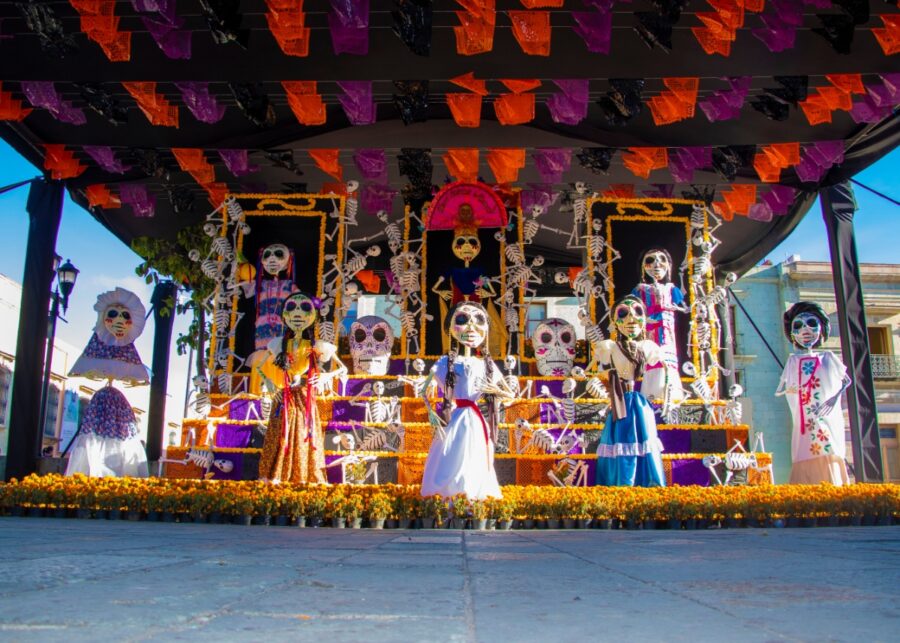
Both cities excel at cultural celebrations, but with different flavors. Mexico City’s Day of the Dead features elaborate ofrendas (altars) in public spaces and a massive parade inspired by the James Bond film “Spectre.” The city blends ancient traditions with modern interpretations.
Oaxaca’s festivals maintain stronger indigenous elements. The Guelaguetza celebration in July showcases traditional dances and costumes from different regions. Día de los Muertos in Oaxaca feels more intimate, with families gathering in cemeteries for all-night vigils surrounded by candles and marigolds.
Religious ceremonies in both cities blend Catholic and pre-Hispanic elements. Mexico City’s Basilica of Guadalupe attracts millions of pilgrims annually, while Oaxaca’s churches host processions that incorporate indigenous spiritual practices. These celebrations offer travelers authentic glimpses into living traditions rather than staged tourist experiences.
See Related: Most Breathtaking Places to Visit in the World (Travel Guide)
Urban Development and Architecture
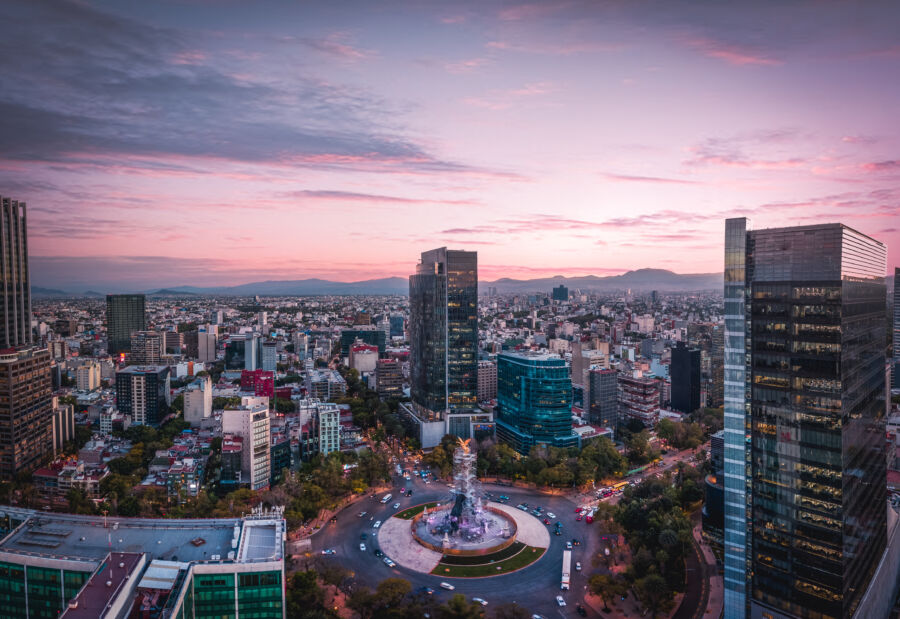
Mexico City and Oaxaca represent two distinct approaches to urban development in Mexico, each with unique architectural styles that reflect their history and environment. Mexico City embraces colonial grandeur and modern innovation, while Oaxaca maintains a more cohesive historical aesthetic that works with its natural surroundings.
Colonial Influences and Contemporary Designs in Mexico City
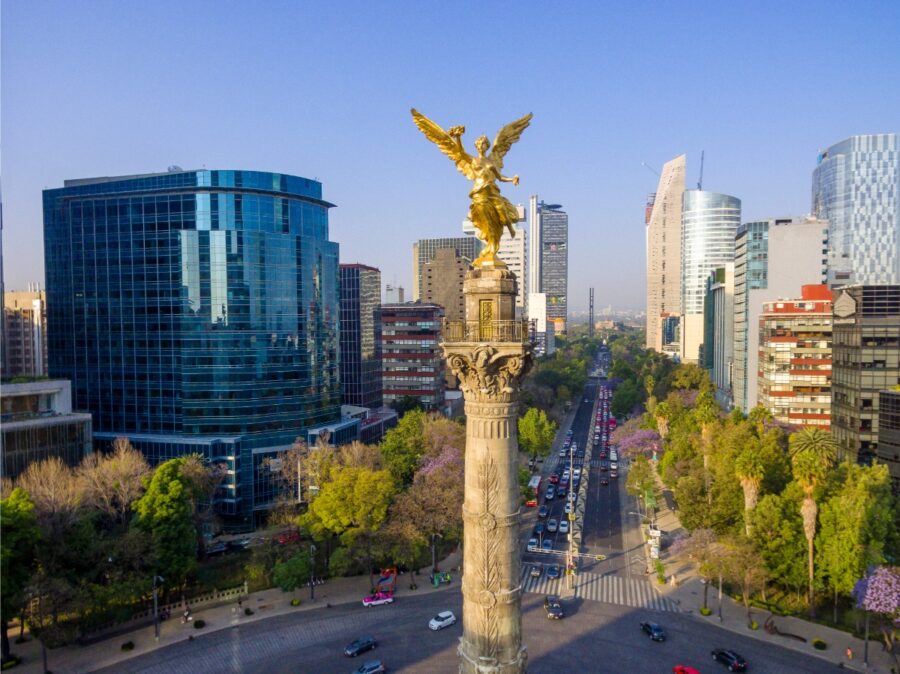
Mexico City’s architectural landscape tells the story of its evolution from Aztec capital to modern metropolis. The historic center showcases Spanish colonial buildings alongside pre-Hispanic ruins, creating a fascinating architectural timeline. The Metropolitan Cathedral and National Palace, with their ornate facades and imposing presence, are impressive examples of colonial grandeur.
In contrast, neighborhoods like Condesa and Roma feature Art Deco and modernist structures from the early 20th century. These areas have become hotbeds for architectural innovation, with renovated historic buildings alongside sleek contemporary designs.
The city continues to evolve, with bold new structures like the Soumaya Museum and Torre Reforma transforming the skyline. This architectural diversity reflects Mexico City’s identity—a place that “seamlessly blends the old with the new” while maintaining its “vibrant street life and historic architecture.”
Oaxaca’s Architectural Harmony with Nature
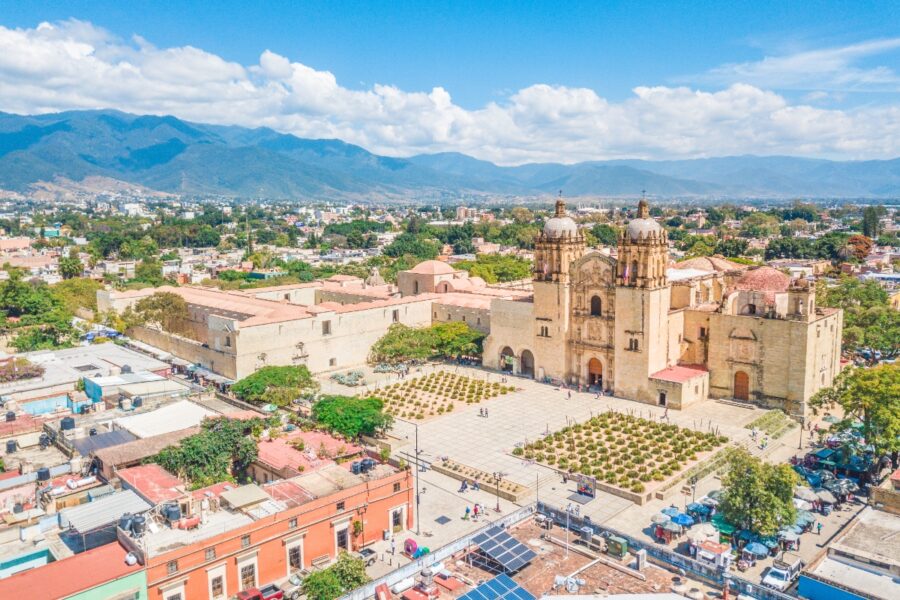
Oaxaca takes a different approach to urban development, prioritizing preservation and harmony with its natural environment. The city’s historic center maintains a cohesive colonial aesthetic with low-rise buildings in warm earth tones that mirror the surrounding landscape.
The Dominican Church of Santo Domingo de Guzmán exemplifies Oaxaca’s Baroque architectural style with its intricate golden interior. Meanwhile, the Ethnobotanical Garden showcases how modern design can complement historical structures while celebrating indigenous plants.
Unlike Mexico City’s vertical expansion, Oaxaca’s development spreads horizontally, respecting the mountainous terrain that cradles the city. This creates an “undulating mess of Spanish architecture” that follows the land’s natural contours rather than fighting against them.
Local materials like green Cantera stone and red clay are prominently featured in historic and new buildings. These give Oaxaca its distinctive warm glow at sunset and reinforce the connection between the built environment and nature.
Culinary Journey
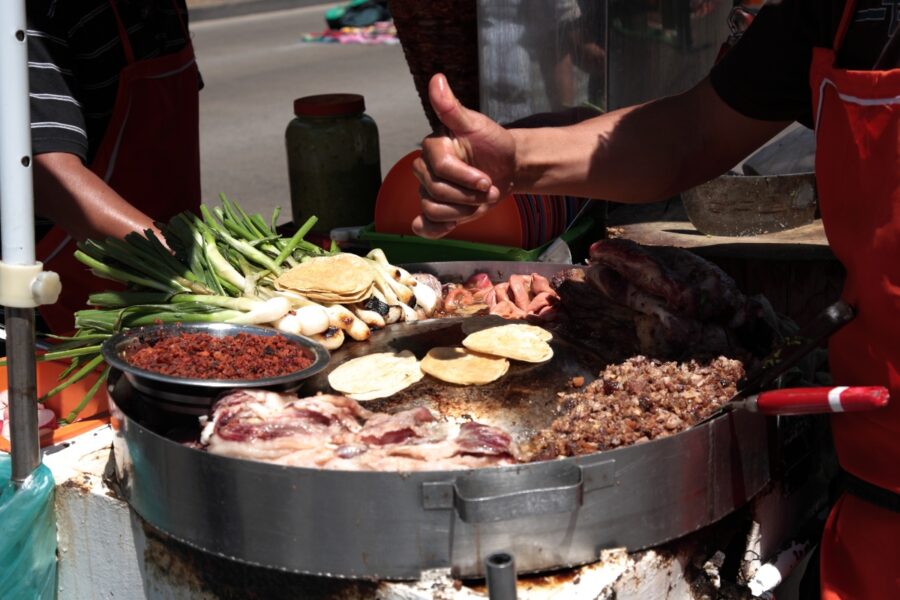
Mexico City and Oaxaca offer incredible food experiences that showcase the diversity of Mexican cuisine. Each city presents distinct flavors, cooking techniques, and ingredients that tell the story of Mexico’s rich culinary heritage.
Distinct Flavors of Mexico City
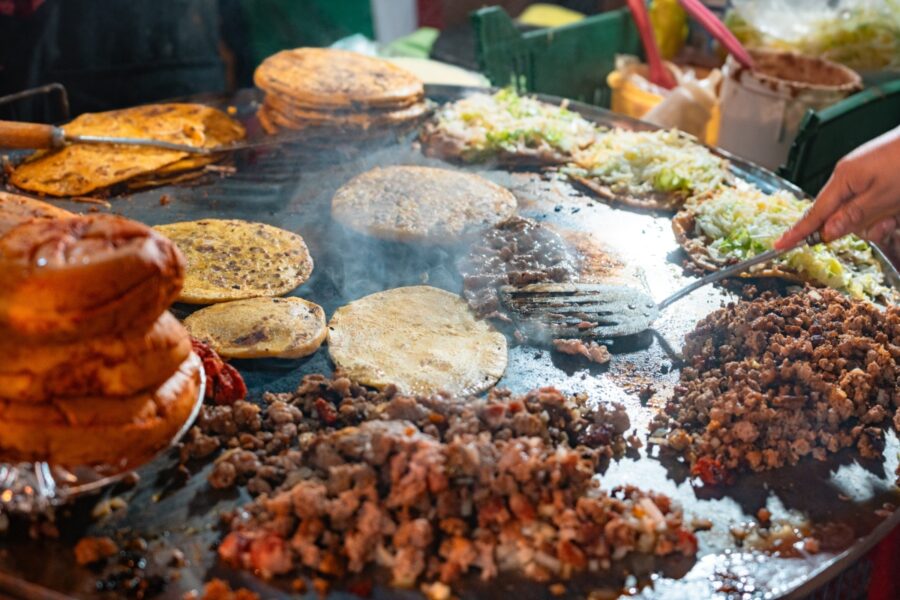
Mexico City serves as a culinary treasure chest where you can taste authentic regional cuisines from all over the country. The city’s food scene combines traditional street food with high-end dining experiences. At markets like Mercado de San Juan, you’ll find everything from exotic fruits to gourmet cheeses.
Street food is a must-try experience here. Tacos al pastor, spinning on vertical spits, are a city specialty you shouldn’t miss. The city’s culinary landscape includes upscale restaurants that reimagine traditional dishes with modern techniques.
Mexico City’s food culture reflects its cosmopolitan nature. You’ll find influences from international cuisines alongside regional Mexican specialties. This makes it perfect for food enthusiasts who want variety in their culinary adventures.
Savor the Unique Tastes of Oaxaca
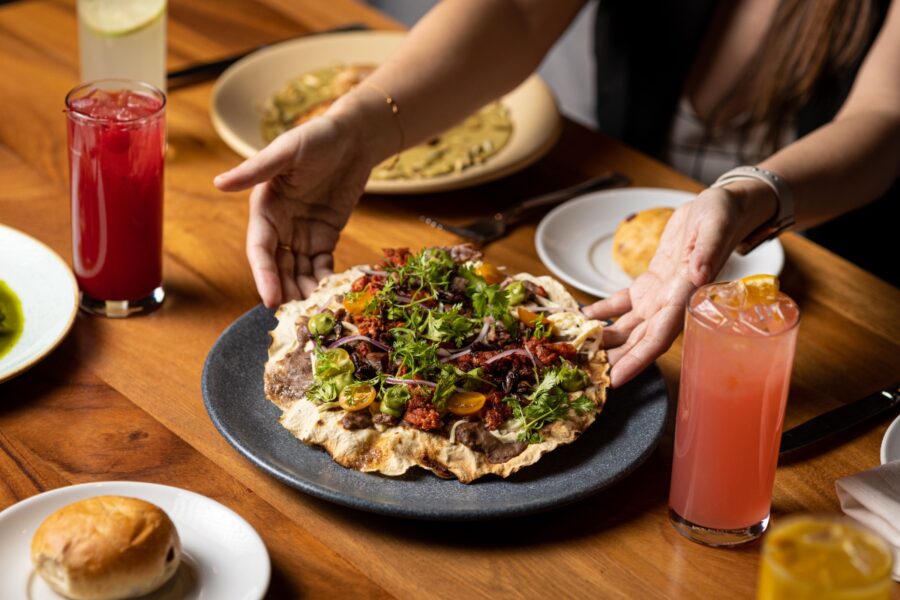
Oaxaca is widely considered Mexico’s culinary heartland. It is famous for its seven legendary moles, including the complex mole negro, which has over 30 ingredients, including chocolate. It is the region’s signature dish.
Mezcal production is deeply rooted in Oaxacan culture. Small distilleries create this smoky spirit using traditional methods passed down through generations. Many offer tastings where you can learn about the production process.
Local specialties include tlayudas (large crispy tortillas topped with beans and meat) and chapulines (toasted grasshoppers). Boulenc, a beloved bakery and restaurant, represents the city’s growing food scene that blends tradition with innovation.
Don’t miss trying Levadura de Olla, a traditional Oaxacan fermented drink. It’s made from pineapple, piloncillo (unrefined sugar), and other fruits, offering a refreshing taste that connects you to ancient culinary traditions.
Artisan Work and Craftsmanship

Mexico’s artistic heritage shines brilliantly through its handcrafted works. Oaxaca and Mexico City offer visitors incredible opportunities to experience authentic Mexican craftsmanship, though each location has developed distinctive artistic traditions.
Handcrafted Textiles and Crafts from Oaxaca
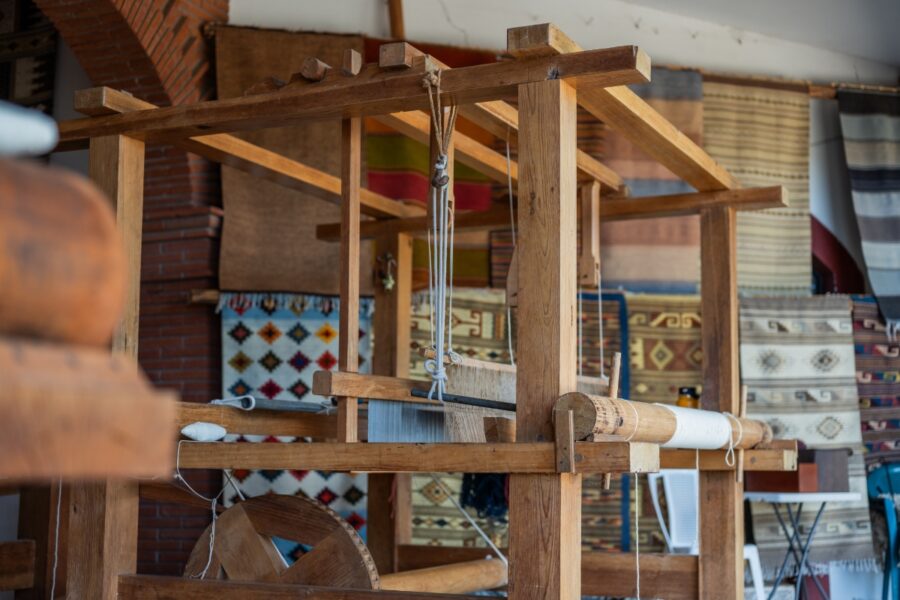
Oaxaca stands as Mexico’s undisputed artisan heartland. The region boasts over 70 different pottery communities, each with unique approaches to clay, glazes, and finishes. This diversity creates an extraordinary tapestry of artistic expression unmatched elsewhere in North America.
The textiles of Oaxaca tell stories through their intricate patterns and vibrant colors. Local artisans still use traditional backstrap looms and natural dyes to create spectacular pieces. You’ll find handwoven rugs (tapetes), embroidered blouses (huipiles), and decorative tablecloths in regional markets.
Sadly, these incredible handicrafts often sell for far too little. Many talented artisans struggle financially despite creating museum-quality work. Some cooperatives like La Casa de las Artesanias are working to change this, helping craftspeople earn fair prices while preserving traditional techniques.
Mexico City’s Evolving Modern Crafts Scene
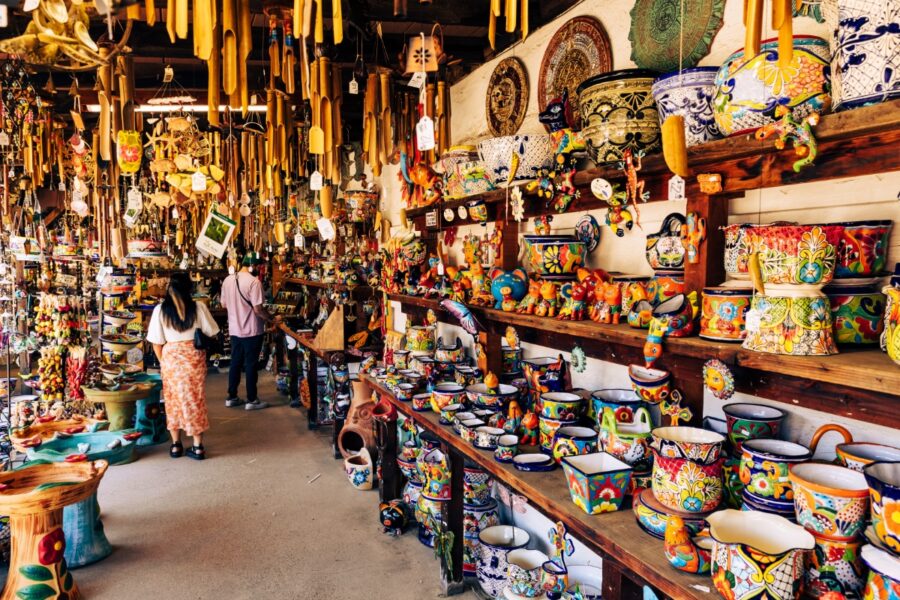
Mexico City blends traditional craftsmanship with contemporary design sensibilities. The capital’s artisan scene reflects its cosmopolitan character, and traditional techniques meet modern aesthetics in exciting ways.
In neighborhoods like Coyoacán and Roma, you’ll discover boutiques featuring innovative Mexican designers who honor indigenous craft traditions while creating pieces for urban consumers. These artists often collaborate with rural artisans, creating economic opportunities while preserving ancient techniques.
Mexico City also hosts major craft exhibitions and markets throughout the year. These events draw talented artisans nationwide, turning the capital into a revolving showcase of Mexico’s diverse craft traditions.
The city’s museums and cultural centers, like the Folk Art Museum, play vital roles in documenting and preserving craft knowledge. They provide crucial context for understanding the cultural significance behind the beautiful objects.
Contemporary Lifestyle Comparisons

The daily lives in Mexico City and Oaxaca reflect their vastly different energies. One offers fast-paced urban living while the other provides a more traditional, relaxed atmosphere that attracts various residents and visitors.
The Bustling Streets of Mexico City: Work and Leisure
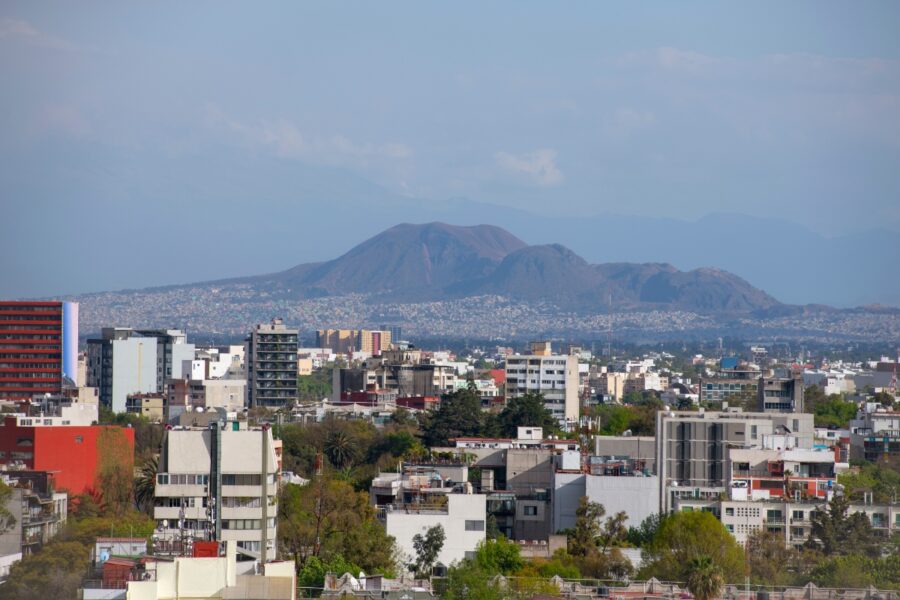
Mexico City pulses with energy 24/7. The neighborhoods of Condesa and Roma are hubs for young professionals, digital nomads, and creatives. Coffee shops buzz with laptops while co-working spaces fill with entrepreneurs.
Weekdays in Mexico City start early with crowded metro cars and busy streets. Many residents face long commutes across this sprawling metropolis. The workday often stretches late into the evening, especially in corporate sectors.
Leisure time here means countless options. You might catch an art exhibit in Condesa, enjoy street food in a bustling market, or dance until dawn at a Roma nightclub. The city offers world-class restaurants, museums, and entertainment.
Shopping ranges from luxury malls to traditional mercados. Parks like Chapultepec provide green escapes from urban intensity. Despite the chaos, Mexico City residents have mastered the art of carving out moments of joy amid the constant motion.
The Relaxed Rhythms of Oaxacan Life

Oaxaca moves to a different beat. The pace is noticeably slower, emphasizing tradition and quality of life rather than hustle. Mornings often begin with leisurely coffee and fresh bread from local bakeries.
The historic Jalatlaco neighborhood exemplifies Oaxacan living with its colorful buildings and walkable streets. Work-life balance exists here, with many businesses closing for afternoon breaks and families gathering for home-cooked meals.
Digital nomads choose Oaxaca for its affordability, reliable internet, and tranquil atmosphere. The cost of living is significantly lower than in Mexico City, allowing for a comfortable lifestyle without the pressure of being in a big city.
Social life centers around the zócalo, where locals and visitors gather in the evenings. Weekends might include visits to nearby villages for artisan markets or natural attractions like Hierve el Agua. Community events, traditional healings, and artisan workshops form the backbone of cultural life.
See Related: Most Beautiful Beaches in the World That Will Steal Your Heart
Economic Perspectives
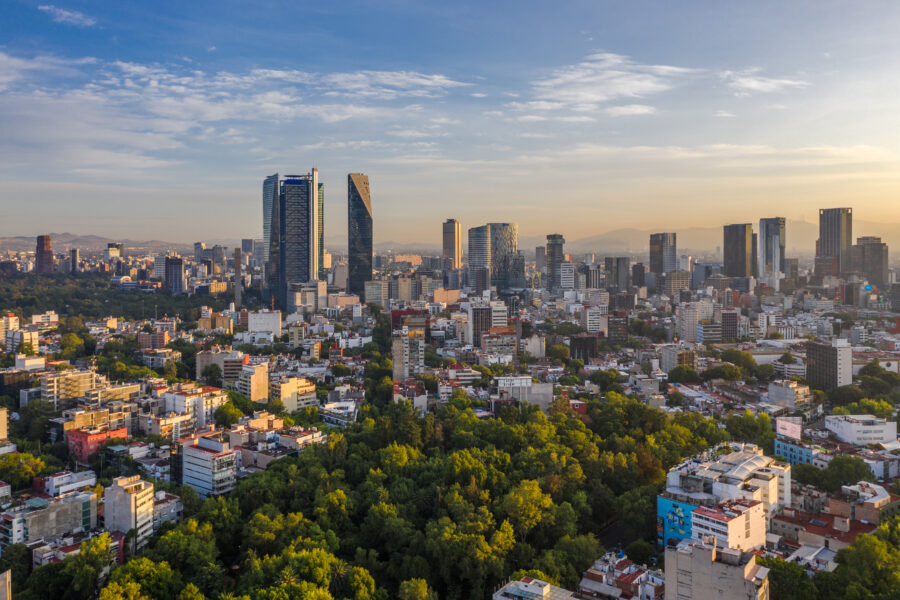
Mexico City and Oaxaca represent two distinct economic models within Mexico, each with its strengths and challenges. The capital showcases Mexico’s modern economy, while Oaxaca demonstrates traditional economic practices that have sustained communities for generations.
Business and Economy in the Capital

Mexico City is the country’s undeniable economic powerhouse. As the nation’s financial hub, it hosts the headquarters of major Mexican corporations, international businesses, and diplomatic missions. The city generates nearly 20% of Mexico’s GDP through diverse sectors, including finance, technology, manufacturing, and tourism.
Employment opportunities in Mexico City far exceed those in other regions, and average salaries are higher than in the rest of the country. The city’s minimum wage is typically higher than in other Mexican states, creating a noticeable income gap.
The capital’s economic advantages come with trade-offs. The cost of living is substantially higher than in Oaxaca, with housing prices in desirable neighborhoods comparable to mid-tier American cities. Transportation infrastructure, while extensive, struggles to keep pace with the growing population.
Oaxaca’s Local Markets and Economic Practices
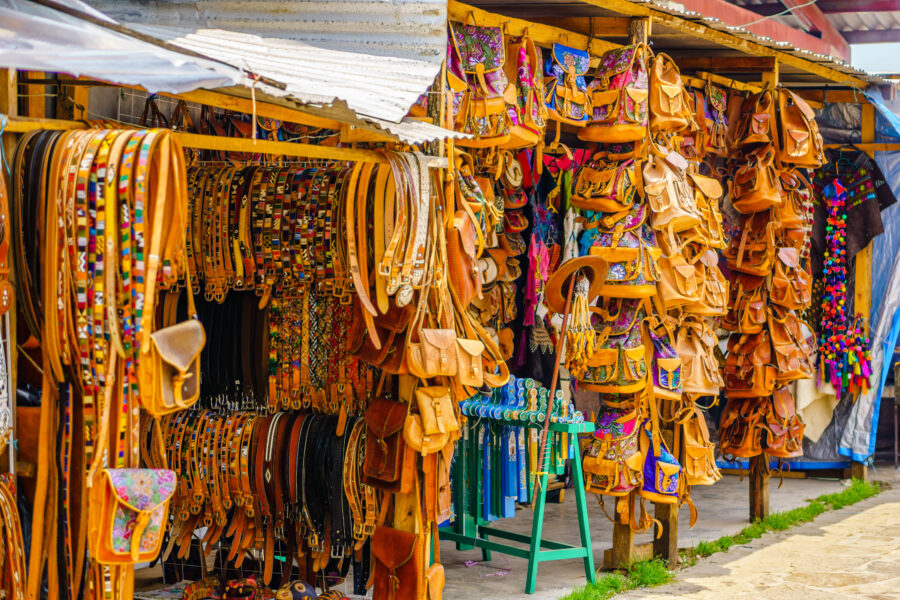
Oaxaca presents a fascinating economic contrast to the capital. According to Mexican government data, Oaxaca ranks as the third most economically marginalized state in Mexico. However, this statistic doesn’t tell the complete story of Oaxaca’s unique economic character.
The state’s economy revolves around traditional markets, artisanal crafts, and agricultural practices. Local mercados feature everything from handwoven textiles to world-renowned cuisine, creating a vibrant micro-economy that supports thousands of families.
Remittances from Oaxacans working abroad play a crucial role in the local economy. Municipalities receiving these funds show higher economic growth and development than those without this income source. This financial lifeline connects Oaxaca to the global economy in surprising ways.
Oaxaca’s conservative public financing approach has recently improved the state’s economic outlook and creditworthiness. While living costs remain significantly lower than Mexico City’s, economic opportunities are more limited, explaining why many young Oaxacans migrate to the capital or abroad for work.
Natural Landscapes and Outdoor Activities

Mexico City and Oaxaca offer stunning natural landscapes for outdoor adventure travelers. While Mexico City surprises visitors with its urban green spaces, Oaxaca showcases breathtaking mountain scenery and biodiversity.
Lush Parks and Green Spaces in Mexico City
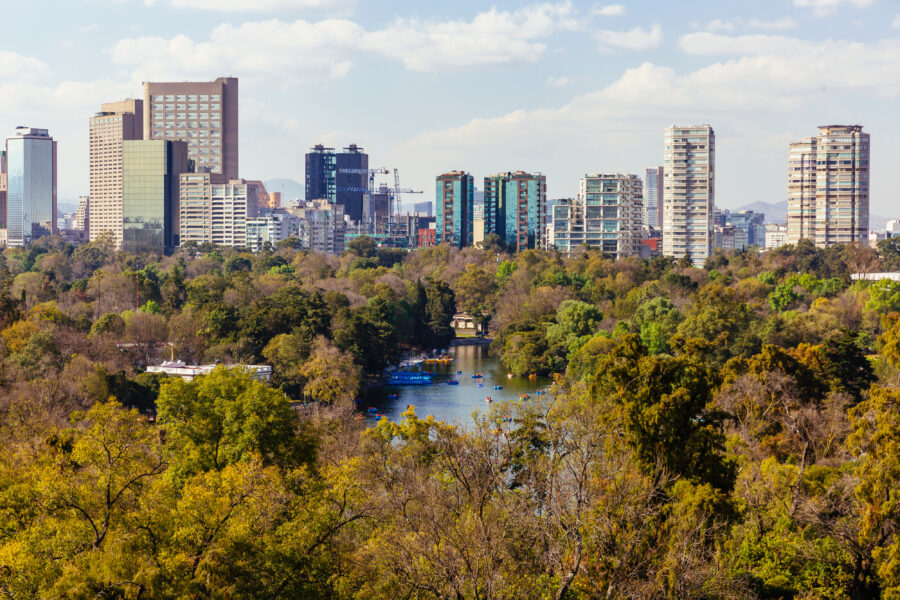
At first glance, Mexico City might seem like a concrete jungle, but it boasts impressive green spaces. Chapultepec Park is one of the largest urban parks in the Western Hemisphere, spanning over 1,700 acres. It’s Mexico City’s version of Central Park, but bigger!
Visitors can rent paddleboats on the park’s peaceful lake or explore the Chapultepec Zoo. The park also houses museums and ancient ruins, making it a cultural and natural hotspot.
Check out Viveros de Coyoacán, a plant nursery and jogging spot locals love for something less touristy. The Floating Gardens of Xochimilco offer another unique experience: travelers can ride colorful trajineras (boats) through ancient canals dating back to Aztec times.
Oaxaca’s Breathtaking Nature and Ecotourism
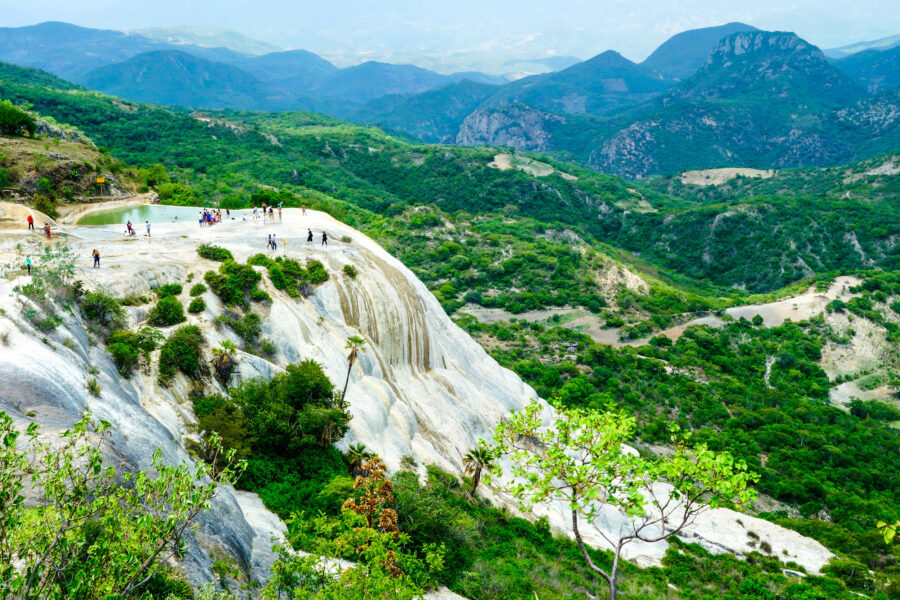
Oaxaca’s natural landscapes are truly spectacular, with the Sierra Norte mountains creating a stunning backdrop to the colonial city. These mountains aren’t just pretty – they offer incredible hiking and village-to-village trekking opportunities through pine and cloud forests.
The state is home to Hierve el Agua, a set of petrified waterfalls that create natural infinity pools overlooking valley vistas. It’s one of the most Instagram-worthy spots in all of Mexico!
Oaxaca’s coastline shouldn’t be overlooked either. The beaches of Puerto Escondido and Huatulco provide opportunities for surfing, snorkeling, and spotting sea turtles. Oaxaca’s biodiversity is remarkable for wildlife enthusiasts – the state harbors nearly 50% of Mexico’s bird species and countless endemic plants.
Many indigenous communities offer authentic ecotourism experiences, during which travelers can learn about sustainable living and traditional relationships with the land.
See Related: The Most Boring Places in the World: Where Excitement Goes to Die
Frequently Asked Questions
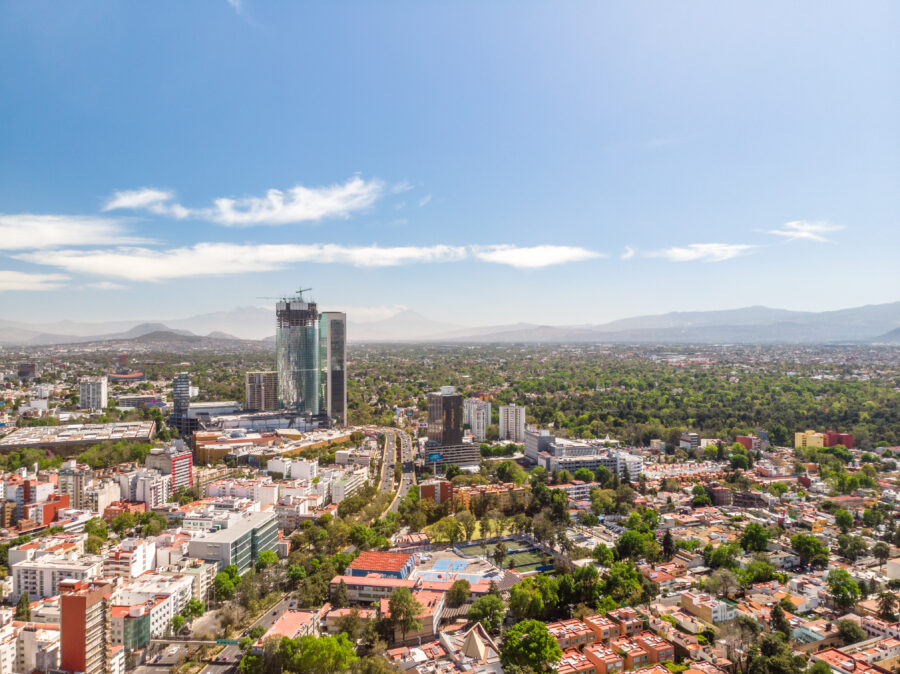
Travelers considering these two Mexican destinations often have specific questions about making the most of their visit. Both cities offer unique experiences but differ significantly in size, pace, and cultural offerings.
What unique experiences distinguish Oaxaca from Mexico City during the Day of the Dead celebrations?
Oaxaca offers a more intimate and traditional Día de los Muertos experience. The city’s compact size means you can walk between cemeteries, markets, and town squares where celebrations occur.
In Oaxaca, families create elaborate sand tapestries (tapetes) in the streets. The comparetas (parades) feature locals dressed as skeletons wandering through colonial streets with live music and mezcal flowing freely.
Mexico City’s celebrations are larger and more diverse. The grand parade down Paseo de la Reforma draws thousands, and giant puppets and elaborate floats accompany it. The city’s numerous neighborhoods also have unique celebrations.
How should one split their time between Mexico City and Oaxaca for an optimal 7-day itinerary?
A balanced 7-day trip might include 4 days in Mexico City and 3 in Oaxaca. Mexico City’s size demands more time to explore its neighborhoods, museums, and archaeological sites, such as Teotihuacan.
Start visiting the historic center, the Frida Kahlo Museum, and the Anthropology Museum in Mexico City. Take a day trip to Teotihuacan before flying to Oaxaca for a more relaxed pace.
In Oaxaca, focus on the historic center, local markets, and the Monte Albán archaeological site. Spend a day exploring mezcal production in the surrounding villages. This split gives you a taste of the cosmopolitan capital and Oaxaca’s more traditional atmosphere.
Can you compare the cultural significance of baseball in Mexico City and Oaxaca?
Baseball holds greater cultural significance in Oaxaca than in Mexico City. The Guerreros de Oaxaca team is a source of regional pride, with games becoming community events that locals passionately attend.
Mexico City’s baseball scene is overshadowed by soccer. The Diablos Rojos del México team has loyal fans, but baseball competes with many other entertainment options in the capital.
Oaxacan baseball has deeper indigenous connections, with many towns having their teams. Games often feature local foods and music, and become all-day social gatherings rather than just sporting events.
What are the best modes of transportation for traveling between Mexico City and Oaxaca, considering comfort and experience?
Flying is the fastest option, taking about 1 hour on airlines like Volaris or Aeromexico. Flights from Mexico City to Oaxaca run multiple times daily and provide spectacular views of the mountains.
First-class buses offer a comfortable alternative, taking 6-7 hours. ADO GL and OCC buses feature reclining seats, bathrooms, and entertainment systems. The scenic route passes through mountains and small villages.
For adventurous travelers, renting a car allows them to explore small towns like Puebla and Tehuacán. However, mountain roads can be challenging, and the journey takes 6-8 hours, depending on the stops.
How do the costs of accommodations, dining, and activities compare between Mexico City and Oaxaca?
Oaxaca is generally 20-30% less expensive than Mexico City. Mid-range hotels in Oaxaca cost $50-80 per night, while similar accommodations in Mexico City run $70-120.
Dining shows a similar pattern. A meal at a good restaurant in Oaxaca averages $10-15 per person, while Mexico City’s equivalent restaurants cost $15-25. Street food is affordable in both cities, but slightly cheaper in Oaxaca.
Activities and entrance fees are comparable, with most museums charging $3-7 in both locations. However, transportation costs are higher in Mexico City due to its size and the need for taxis or rideshares between distant attractions.
How do the offerings in Mexico City and Oaxaca differ for those interested in the arts and culinary scenes?
Mexico City boasts world-class museums like Museo Soumaya and Palacio de Bellas Artes. Major galleries in the Condesa and Roma neighborhoods showcase established and emerging artists, making the art scene international and contemporary.
Oaxaca focuses more on traditional and indigenous arts. The city is famous for alebrijes (colorful wooden carvings), black clay pottery, and textiles. Small workshops and studios allow visitors to meet artists directly.
Culinary experiences differ dramatically. Mexico City offers diverse international cuisine alongside regional Mexican foods. Oaxaca is Mexico’s culinary heartland, specializing in seven distinct moles, tlayudas, and artisanal mezcal production that visitors can experience through cooking classes and market tours.



